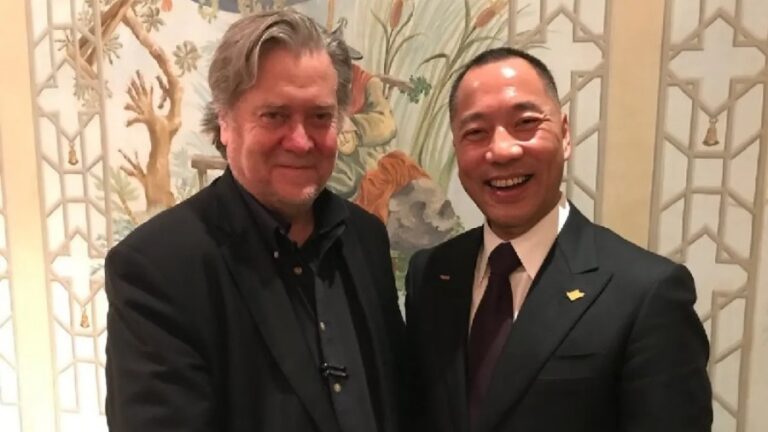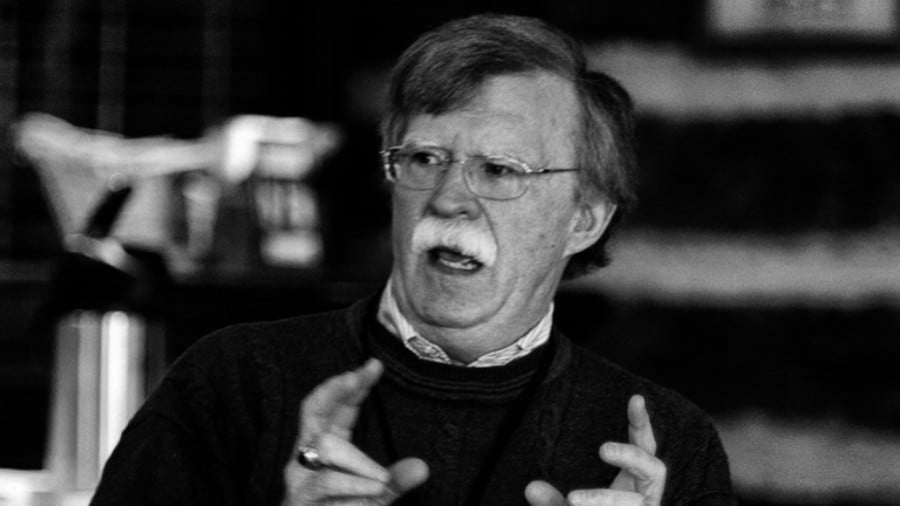How US Media Misrepresent the Wuhan Institute of Virology’s Laboratories and Safety Protocols
While many people have already criticized the lack of evidence and scientific basis for the hypothesis that the Covid-19 pandemic originated from a laboratory, both critics and proponents of the lab-leak theory appear to have uncritically accepted false or unproven premises regarding work done at the laboratory most often implicated in these speculations, the Wuhan Institute of Virology (WIV).
Some of the most prominent accusations pointed at the WIV are that it was conducting research as part of China’s alleged biowarfare program, and was conducting its experiments in substandard biosafety conditions. The implication is that if the WIV lied about not having SARS-CoV-2 before the outbreak, the virus would also be more likely to have originated from there owing to their inadequate biosafety standards. However, after investigating these widely circulated claims and contacting several scientists, it turns out there is actually little evidence for any of these allegations.
State Department cable a ‘nothing burger’
The claim that the WIV was conducting its experiments in substandard or unsafe working conditions started gaining mainstream acceptance when Washington Post columnist Josh Rogin published an op-ed based on redacted State Department cables from 2018. Rogin claimed that the redacted cables were evidence of “safety issues” at the WIV:
Two years before the novel coronavirus pandemic upended the world, U.S. Embassy officials visited a Chinese research facility in the city of Wuhan several times and sent two official warnings back to Washington about inadequate safety at the lab, which was conducting risky studies on coronaviruses from bats.
What the U.S. officials learned during their visits concerned them so much that they dispatched two diplomatic cables categorized as Sensitive But Unclassified back to Washington. The cables warned about safety and management weaknesses at the WIV lab and proposed more attention and help. The first cable, which I obtained, also warns that the lab’s work on bat coronaviruses and their potential human transmission represented a risk of a new SARS-like pandemic.
Certainly, when reading Rogin’s contrived interpretations of the cables, it’s understandable why these characterizations of the WIV’s biosafety standards would create a sense of mass panic and hysteria among people unfamiliar with laboratory work. However, around the time of publication, Rogin’s opinion piece was already criticized by experts like virologist Angela Rasmussen at the University of Saskatchewan, who tweeted that Rogin’s claims were not only “extremely vague” — with the portions of the cables cited not demonstrating a “clear and specific risk” — but also highly inaccurate.
The sections Rogin cites from the January 19, 2018 cable are:
During interactions with scientists at the WIV laboratory, they noted the new lab has a serious shortage of appropriately trained technicians and investigators needed to safely operate this high-containment laboratory…
Most importantly, the researchers also showed that various SARS-like coronaviruses can interact with ACE2, the human receptor identified for SARS-coronavirus. This finding strongly suggests that SARS-like coronaviruses from bats can be transmitted to humans to cause SARS-like diseases. From a public health perspective, this makes the continued surveillance of SARS-like coronaviruses in bats and study of the animal-human interface critical to future emerging coronavirus outbreak prediction and prevention.
Rasmussen pointed out the main takeaway is that the cables conclude “it’s important to continue working on bat CoVs because of their potential as human pathogens,” and that it “doesn’t suggest that there were safety issues specifically relating to WIV’s work on bat CoVs capable of using human ACE2 as a receptor.” Other critics at the time argued that if Rogin truly believed the State Department cable was as damning for Beijing as he claimed it was, there was little reason for him to refuse to release its full contents in his op-ed upon publication, or when people voiced their skepticism of his presentation of it afterward.
Rasmussen’s skepticism and expert judgment were vindicated three months later, when the Post released the full cable after it filed a Freedom of Information Act (FOIA) lawsuit, and reported that Rogin’s selective leaks “sparked unproven speculation.” It noted, “The full cable does not strengthen the claim that an accident at the lab caused the virus to escape, nor does it exclude the possibility.”
Rasmussen later remarked that the full cable is a “big old nothing burger,” because it doesn’t actually raise any concerns with the WIV’s work. Rather, the cable showed how the WIV “wanted to ensure staff working with dangerous pathogens were trained so they could do so safely.” This would explain why the cable requested further aid and training for the lab’s projects and personnel, instead of trying to cancel them.
The Post also pointed out that the lack of trained personnel is not a problem unique to the WIV, as it cited Rob Grenfell, the director of health and biosecurity at the Commonwealth Scientific and Industrial Research Organization (an Australian government biomedical research agency), saying “All [such] facilities around the world face this challenge.”
No proof WIV’s BSL-4 lab involved with bioweapons research
As confirmed by the release of the full cable, the “new lab” mentioned is the WIV’s BSL-4 laboratory (the highest biosafety level), which first opened in 2018. Many irrelevant speculations have surrounded this BSL-4 facility, as it deals with the most dangerous pathogens, like smallpox and SARS-CoV-1, that cannot be handled at lower biosafety levels.
Journalist Sam Husseini, one of the biggest promoters of the laboratory origin hypothesis, has recounted his suspicions regarding the possibility of the SARS-CoV-2 virus originating from the WIV’s BSL-4 laboratory when he asked a CDC representative about the facility:
I asked if it was a “complete coincidence” that the pandemic had started in Wuhan, the only place in China with a declared biosafety level 4 (BSL4) laboratory. BSL4 laboratories have the most stringent safety mechanisms, but handle the most deadly pathogens.
Husseini goes as far as to insinuate that the mere existence of a BSL-4 laboratory is evidence of China’s biowarfare program, largely based on his assertion that the concepts of “biodefense” and “biowarfare” are “largely indistinguishable:”
“Biodefense” implies tacit biowarfare, breeding more dangerous pathogens for the alleged purpose of finding a way to fight them….
The U.S. and China each have dual-use biowarfare/biodefense programs. China has major facilities at Wuhan — a biosafety level 4 lab and a biosafety level 2 lab. There are leaks from labs.
The talking point that the distinction between concepts like “biowarfare” and “biodefense” is merely a “rhetorical sleight of hand” is a popular assertion among journalists promoting the lab-leak theory’s legitimacy, as journalist Glenn Greenwald also claimed something similar:
But ultimately, that distinction barely matters. For both offensive and defensive bioweapons research, scientists must create, cultivate, manipulate and store non-natural viruses or infectious bacteria in their labs, whether to study them for weaponization or for vaccines.
These claims by journalists with no formal science background struck me as far-fetched, so I contacted microbiologist Stanley Perlman at the University of Iowa, virologist Stephen Goldstein at the University of Utah, and virologist James Duehr at the University of Pittsburgh, to check these assertions. Both Perlman and Goldstein simply rejected the assertion that “biowarfare” and “biodefense” are “largely indistinguishable” concepts, with Perlman stating that the claim “doesn’t make sense.” Duehr responded:
Saying that there is no difference between “biodefense” and “biowarfare” is like saying there is no difference between developing bullet-proof vests and armor-piercing bullets. Sure, knowing how one works helps you develop better versions of the other, but conflating them is really missing the point.”
Australian virologist Danielle Anderson, the only foreign scientist to work in the WIV’s BSL-4 laboratory until November 2019, has attested that claiming “the Wuhan Institute of Virology as ‘one of only two bioweapons research labs in all of China’ is simply false,” undermining Husseini’s claim that the WIV’s BSL-4 lab is evidence of China’s alleged dual-use “biowarfare” program. Critics of Husseini’s allegation that the WIV is engaged in “biowarfare” research — one being Claudia Chaufan, director of the graduate program of health policy at York University — have punctured his logic on several grounds. Chaufan stated:
That linguistic sleight of hand in particular, the equivalence of biowarfare and biodefense, is factually not true, and is certainly not true in one very obvious way regarding the Wuhan lab: If there were a biowarfare arms race happening around the world, the countries putatively at war with each other — the U.S. and China — would not share or allow access to their labs to a competitor state, collaborate, or exchange their research and researchers.
But the fact is the U.S. was given wide access to the Wuhan Labs — not just scientists but also U.S. State Department functionaries — as were French scientists. The Wuhan lab solicited U.S. aid and funding. (Husseini seems to believe that biowarfare labs openly solicit funding from other countries). Scientists in the U.S. and China collaborated and worked together collegially, trained each other, shared information, published papers and still maintain some relations.”

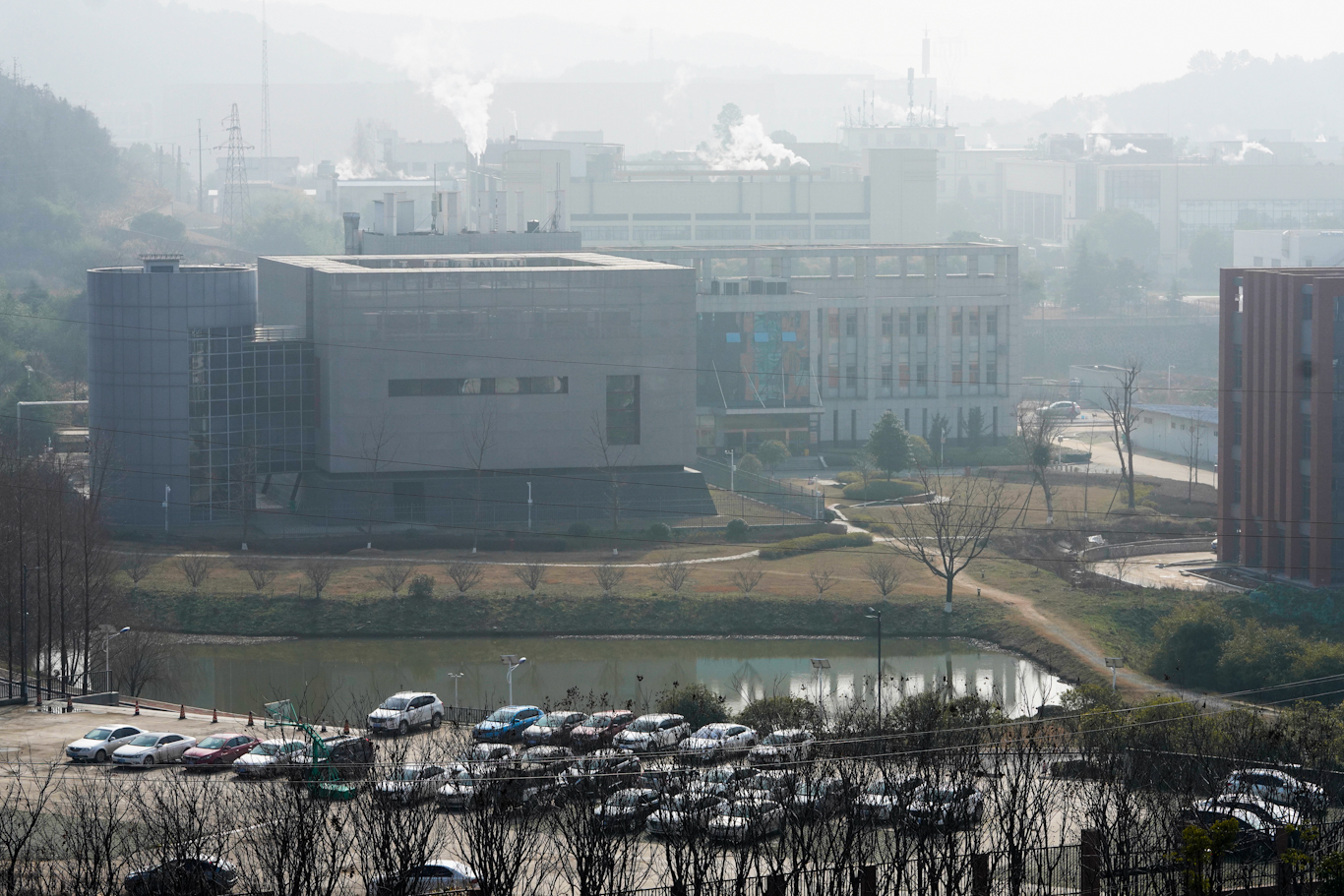
It is true that the WIV has carried out unspecified classified research projects, and has heightened secrecy due to the inherent national security risks of handling dangerous pathogens. However, it’s also true that initial reports explained why WIV officials claimed that “transparency is the basis” for the BSL-4 lab, and why the WIV frequently collaborates with foreign scientists and openly publishes its research — further undermining the allegation that bioweapons research is being conducted there. According to the scientific journal Nature, when the BSL-4 lab was getting cleared to operate:
It will focus on the control of emerging diseases, store purified viruses and act as a World Health Organization ‘reference laboratory’ linked to similar labs around the world. “It will be a key node in the global biosafety-lab network,” says lab director Yuan Zhiming…
The opportunities for international collaboration, meanwhile, will aid the genetic analysis and epidemiology of emergent diseases.
The preventive (rather than militaristic) nature of the WIV’s research is also corroborated by the judgments of U.S. diplomats in the Post’s unredacted State Department cable when it described how the 2002-03 SARS outbreak “convinced China to prioritize international cooperation for infectious disease control:”
This state-of-the-art facility is designed for prevention and control research on diseases that require the highest level of biosafety and biosecurity containment.
WIV’s biosafety practices not substandard
For the sake of argument, even if one grants the unproven premise that the WIV’s BSL-4 lab was engaged in bioweapons research, it is still irrelevant to the question of whether SARS-CoV-2 originated there, since the WIV doesn’t conduct coronavirus research at a BSL-4 setting. Most coronavirus research around the world is conducted at BSL-2 and BSL-3 settings.
This demonstrates that those who suspect the pandemic originated from the WIV’s BSL-4 lab don’t seem to be aware of basic information about coronavirus research. Some notable examples are people like novelist Nicholson Baker citing Husseini’s suspicions of the WIV’s BSL-4 facility in a lengthy speculative piece for New York Magazine. Others include Josh Rogin citing similarly ignorant anonymous Trump administration officials to imply that the irrelevant State Department cable is “evidence” that supports “the possibility that the pandemic is the result of a lab accident in Wuhan.”
However, lab-leak proponents like disgraced science writer Nicholas Wade — who penned an influential Medium blog post that was later reprinted by the Bulletin of the Atomic Scientists — are also fond of moving the goalposts to argue their evidence-free conspiracy theory. Wade cites Rogin’s long-debunked and irrelevant op-ed to claim that the BSL-4 lab’s “state of readiness considerably alarmed the State Department inspectors who visited it from the Beijing embassy in 2018,” before going on to make an entirely separate argument that the WIV’s biosafety standards were substandard and amounted to professional malpractice:
The real problem, however, was not the unsafe state of the Wuhan BSL4 lab but the fact that virologists worldwide don’t like working in BSL4 conditions….
Before 2020, the rules followed by virologists in China and elsewhere required that experiments with the SARS1 and MERS viruses be conducted in BSL3 conditions. But all other bat coronaviruses could be studied in BSL2, the next level down. BSL2 requires taking fairly minimal safety precautions, such as wearing lab coats and gloves, not sucking up liquids in a pipette, and putting up biohazard warning signs. Yet a gain-of-function experiment [wherein a pathogen is reasonably anticipated to gain enhanced virulence and/or transmissibility] conducted in BSL2 might produce an agent more infectious than either SARS1 or MERS. And if it did, then lab workers would stand a high chance of infection, especially if unvaccinated.
Wade briefly explained biosafety levels to readers before taking a quote from Dr. Shi Zhengli — the renowned virologist at the WIV — out of context to maximize the impression that the WIV’s biosafety standards were unprofessional:
There are four degrees of safety, designated BSL1 to BSL4, with BSL4 being the most restrictive and designed for deadly pathogens like the Ebola virus….
Much of Shi’s work on gain-of-function in coronaviruses was performed at the BSL2 safety level, as is stated in her publications and other documents. She has said in an interview with Science magazine that “[t]he coronavirus research in our laboratory is conducted in BSL-2 or BSL-3 laboratories.”
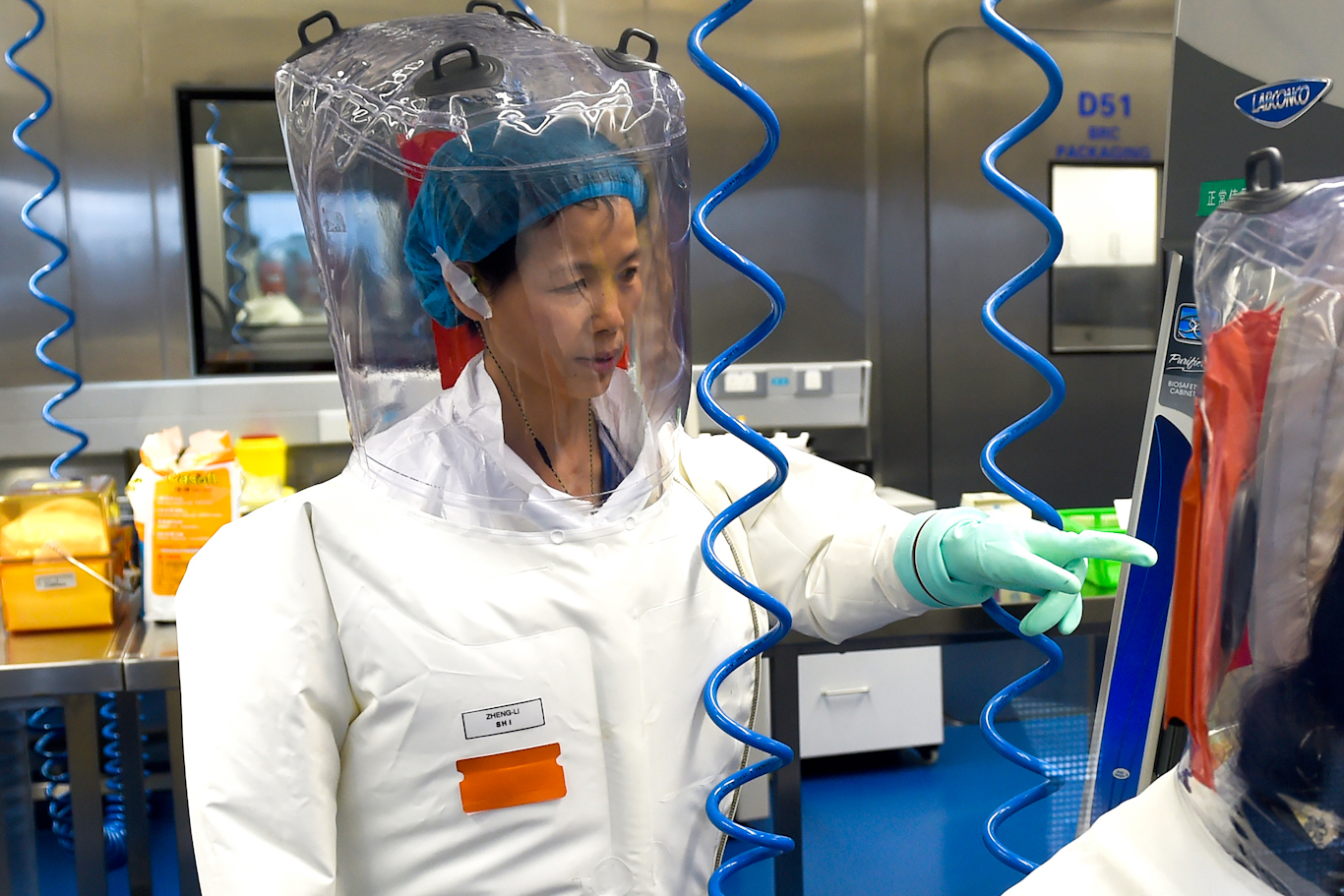
Wade also seemed comfortable parroting molecular biologist Richard Ebright’s heavily disputed claim that BSL-2 conditions are about as safe as a “dentist’s office,” which has been uncritically parroted in other reports as well:
“It is clear that some or all of this work was being performed using a biosafety standard — biosafety level 2, the biosafety level of a standard U.S. dentist’s office — that would pose an unacceptably high risk of infection of laboratory staff upon contact with a virus having the transmission properties of SARS-CoV-2,” Ebright says.
Although Wade provides the link to the Science interview, he omits crucial context that dramatically changes the impression of Shi’s answer and the professionalism of the WIV’s work. When one actually reads the interview, one quickly discovers that the interviewer takes it for granted that most coronavirus research is actually conducted in BSL-2 and BSL-3 settings:
Q: Given that coronavirus research in most places is done in BSL-2 or BSL-3 Labs — and indeed, your WIV didn’t even have an operational BSL-4 until recently — why would you do any coronavirus experiments under BSL-4 conditions?
University of Utah virologist Goldstein also explained why likening a BSL-2 lab to a dentist’s office is a “ridiculous comparison:”
In BSL2, experiments are conducted inside a class II biosafety cabinet. These have negative pressure, so air circulates within the cabinet but doesn’t escape, and the air is HEPA filtered as it circulates inside the cabinet. A dentist’s office has none of these critical safety controls.”
This helps prevent aerosol droplets or splashes of samples (like viruses) from traveling around inside the air of the cabinet — though one can simply see for oneself how a biosafety cabinet works, and the proper precautions scientists follow while using it, to confirm how it differs from a mere “dentist’s office.”
Wade actually provides yet another damning instance of misrepresenting sources — consistent with his history of misrepresenting scientists — when he critiques an influential Nature letter ( he mischaracterizes it as a mere “opinion piece,” instead of being a short report on original research for “an outstanding finding”), which corroborates the opposite of what Wade claims in his blog post. The Nature letter in question is a study by a group of virologists led by Kristian Andersen, and it states that the “possibility of an inadvertent laboratory release of SARS-CoV-2” must be examined because SARS-like viruses (not SARS-CoV-1) found in bats are often studied at BSL-2 settings:
Basic research involving passage of bat SARS-CoV-like coronaviruses in cell culture and/or animal models has been ongoing for many years in biosafety level 2 laboratories across the world, and there are documented instances of laboratory escapes of SARS-CoV.
The authors later concluded that they “do not believe any type of laboratory-based scenario is plausible,” and the statements above undermine Wade’s depiction of the WIV’s professionalism.
When I asked Dr. Goldstein and Dr. Perlman (who both research coronaviruses) to confirm this information, they each agreed that most coronavirus research is done at BSL-2 and BSL-3 laboratories and that there’s nothing unusual about Chinese scientists also doing coronavirus research in those settings. Goldstein declined to specifically comment on the quality of the WIV because he has never visited, and Perlman suggested that some scientists were concerned about experiments with bat viruses being performed at BSL-2 settings, even if they were “all done following the precautions used at the time.”
However, Dr. Rasmussen clarified in a tweet that “many labs studied bat CoVs at BSL2 pre-Covid,” and that “there is no evidence that lab work was occurring with substandard containment,” further corroborating the claim in the Nature study, though she seemed to suggest that the practice “should be revisited.” Dr. Duehr also explained that “more biosafety controls are not always better,” and that “too many biosafety controls can also be dangerous,” because that can lead scientists to become fatigued and careless, as how scientists put on and take off gear are some of the most important moments in biosafety. This is why scientists use the appropriate amount of biosafety controls, rather than pointlessly using the most restrictive equipment for every experiment.
Experiments with bat viruses in BSL-2 labs
MIT’s Technology Review article “Inside the Risky Bat-Virus Engineering That Links America to Wuhan” cited a few scientists critical of the WIV conducting similar experiments to the heavily scrutinized 2015 Nature study, led by virologist Ralph Baric (which has frequently been misrepresented as “gain-of-function” research), at a lower biosafety setting than the ones conducted at the University of North Carolina:
The Chinese work was carried out at biosafety level 2 (BSL-2), a much lower tier than Baric’s BSL-3+….
Today a chorus of scientists, including Baric, are coming forward to say this was a misstep. Even if there is no link to Covid-19, allowing work on potentially dangerous bat viruses at BSL-2 is “an actual scandal,” says Michael Lin, a bioengineer at Stanford University.
In response to the news that the WIV conducted more experiments with bat virus WIV1 at the BSL-2 level in another study published in 2017, Technology Review cited criticisms from other virologists like Ian Lipkin:
“That’s screwed up,” the Columbia University virologist Ian Lipkin, who co-authored the seminal paper arguing that covid must have had a natural origin, told the journalist Donald McNeil Jr. “It shouldn’t have happened. People should not be looking at bat viruses in BSL-2 labs. My view has changed.”
However, Dr. Duehr explained to me that the U.S. CDC’s own Biosafety in Microbiological and Biomedical Laboratories manual states that viruses related to “Risk Group 3” pathogens (the kinds typically handled at BSL-3), which lack the virulence in humans that the BSL-3 viruses have, can often be safely handled in BSL-2 or BSL-2+ settings (p. 307).
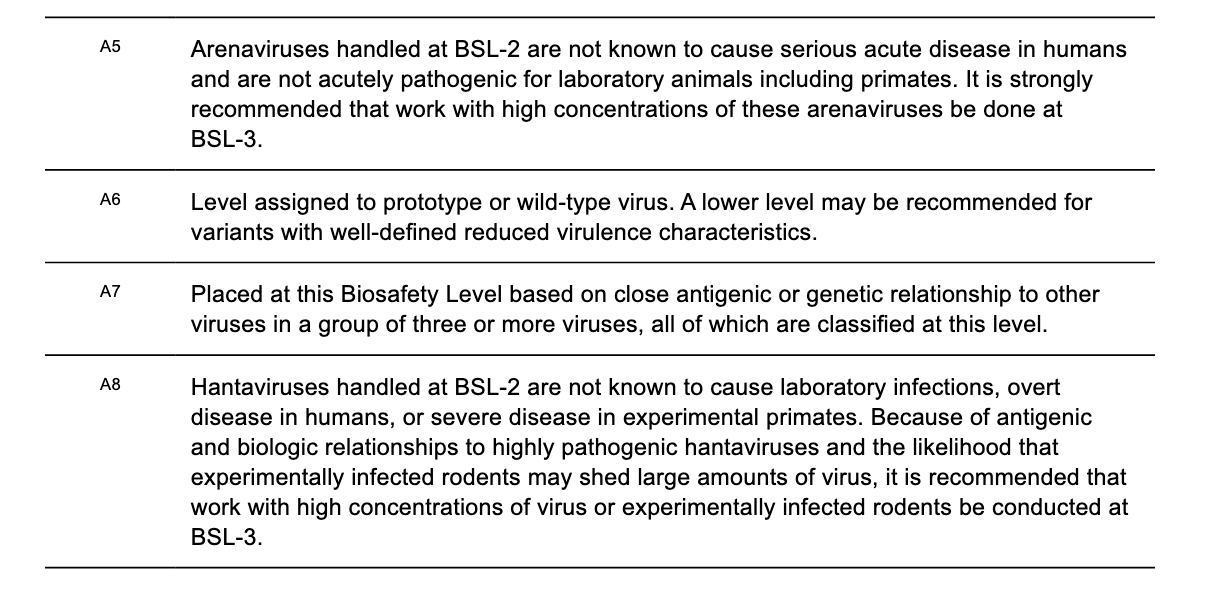
This is precisely Dr. Shi’s explanation given to Technology Review for conducting experiments with the WIV1 virus in a BSL-2 lab:
In an email, Zhengli Shi said she followed Chinese rules that are similar to those in the U.S. Safety requirements are based on what virus you are studying. Since bat viruses like WIV1 haven’t been confirmed to cause disease in human beings, her biosafety committee recommended BSL-2 for engineering them and testing them and BSL-3 for any animal experiments.
Duehr also explained that the SARS-like bat viruses used in the Baric study appear to have previously infected humans, but that those persons didn’t recall any symptoms or worrisome illnesses. Given that data, it was reasonable to infer that any infection was likely either asymptomatic or extremely mild, so a similar rationale would explain why scientists inferred these viruses were less virulent and could be handled at a lower biosafety level. Duehr expressed agreement with Dr. Rasmussen’s statement that the scientific community should reconsider the practice of conducting experiments with bat coronaviruses that haven’t been shown to be virulent in humans in BSL-2 laboratories, but also stated that we “should not fault researchers at the WIV for doing what was common practice all around the world at the time.”
Intercept’s reporting is actually evidence against a lab leak
Two recent reports on a grant from the National Institutes of Health (NIH) to the EcoHealth Alliance — detailing research by the WIV, following FOIA litigation by The Intercept — were misleadingly presented as “new evidence” that U.S.-funded experiments in China “posed biosafety risks” and constituted “high-risk research.” However, it is unclear whether Intercept journalists Sharon Lerner and Mara Hvistendahl understood the significance of the documents they obtained.
Soon after the publication of the first report, Dr. Goldstein argued that The Intercept actually provided evidence against a lab leak because they further confirmed what we have already known since the beginning of the pandemic: that the WIV was only working on “SARS1-like viruses,” with “not a hint of experimental work” on viruses related to SARS-CoV-2.
Virologist Stuart Neil stated on Twitter that there’s “absolutely nothing new here” apart from “disabusing everyone of the notion that animal experiments were carried out at BSL2” because they were carried out in a BSL3 animal facility at the Wuhan University Center for Animal Experiment, and not at the WIV as was previously assumed, which is “entirely appropriate for this work and should provide more than adequate containment.” Dr. Duehr added that the grant also shows us that WIV scientists were doing animal work with SARS-like bat coronaviruses at BSL-3 (not SARS-CoV-1 or 2) (p. 126), which is also how American scientists would handle these bat viruses.
The Intercept also credulously cites biologist and prominent lab-leak booster Alina Chan’s fearmongering and irrelevant speculations that WIV researchers potentially getting bitten by a bat during fieldwork could have led to the pandemic, citing a risk assessment of some of the WIV’s fieldwork:
The grant proposal acknowledges some of those dangers: “Fieldwork involves the highest risk of exposure to SARS or other CoVs, while working in caves with high bat density overhead and the potential for fecal dust to be inhaled.”
Alina Chan, a molecular biologist at the Broad Institute, said the documents show that EcoHealth Alliance has reason to take the lab-leak theory seriously. “In this proposal, they actually point out that they know how risky this work is. They keep talking about people potentially getting bitten — and they kept records of everyone who got bitten,” Chan said. “Does EcoHealth have those records? And if not, how can they possibly rule out a research-related accident?”
However, it would actually be more worrisome if there were no risk assessments for fieldwork to cite at all. Dr. Neil ridiculed Dr. Chan on Twitter for criticizing scientists for writing “a proper risk assessment” for fieldwork “after all the accusations of unsafe working.” Dr. Perlman stated that scientists “have to write risk assessments for their work” in order to get funded and that it was “the right thing to do.”
But perhaps more importantly, citing Dr. Chan’s speculations about the pandemic originating from a bat bite is proof that neither she nor The Intercept’s journalists are aware of basic information about SARS-CoV-2 being a respiratory virus.
In order for that scenario to have any basis, SARS-CoV-2 would also have to be a bloodborne pathogen because the virus from an infected animal bite would pierce the skin and enter the bloodstream, but there is no evidence of SARS-CoV-2 being a bloodborne pathogen. Dr. Rasmussen pointed out that there is no known case of anyone contracting a sarbecovirus like SARS-CoV-1 and SARS-CoV-2 from an animal bite, and that while it is “theoretically possible,” it does not actually happen in real life because, as the FDA’s own website confirms, respiratory viruses generally aren’t known to spread via blood-mediated transmission. Dr. Perlman agreed with Rasmussen’s statements and told me that if he were bitten by a bat during fieldwork, he’d “worry about rabies,” not SARS-CoV-2.
It’s also unclear why Dr. Chan is still repeating her baseless claims when Dr. Rasmussen had already criticized her “inexperience with virology” for speculating that it’s “plausible” for humans to be infected by a mouse-adapted strain of coronavirus if lab workers were bitten by mice back in January.
Perhaps The Intercept would not have presented their documents in a way that promotes the lab-leak theory despite it being evidence of the opposite, or published Dr. Chan’s embarrassing speculations, had they sought out other scientists who could have helped them understand their material. But the only scientists asked to opine on the significance of their documents in their bad-faith report were lab-leak boosters like Richard Ebright and Alina Chan.
A second Intercept article cited virologist Jesse Bloom’s opinion that the WIV “creating chimeras of SARS-related bat coronaviruses that are thought to pose high risk to humans entails unacceptable risks.” However, the virus being discussed in the article is WIV1, which hasn’t been shown to cause disease in humans, which is why Dr. Perlman stated that he thinks it’s “not a risk” to study it and that some of the titles of Dr. Baric’s papers on the virus, like “SARS-like WIV1-CoV poised for human emergence,” may have given the “misleading impression” that it was. Dr. Duehr also agreed that it isn’t a risk to study a SARS-like virus like WIV1, and told me:
The chimeric experiments that Bloom says we should not be doing, are how we find out whether it would pose a risk to humans. He’s assuming that we know the virus is high risk before doing them.”
Dr. Rasmussen disagreed with Dr. Bloom’s personal assessment of the WIV1 experiments and questioned why he thinks he should be the sole arbiter of whether the experiments posed an “unacceptable risk,” when the WIV’s work is subject to external oversight (which is how it was FOIA-ed), and showed that WIV scientists aren’t reckless and don’t singlehandedly decide what is an acceptable risk or not.
Judgments of scientists directly familiar with the WIV
Arguably, the opinions of scientists and biosecurity experts directly familiar with the WIV’s safety protocols should count more than others. And they paint a very different picture from the one painted by the critics, and argue that reports insinuating that the laboratory was operating under subpar safety conditions are misrepresentations.
French biosecurity expert Gabriel Gras — who oversaw safety standards at the WIV from 2012 to 2017, since the WIV’s BSL-4 laboratory is a joint collaboration between China and France — dismissed the lab-leak theory and vouched for the WIV’s professionalism and safety standards. He also stated that a BSL-3 laboratory is usually used to study a coronavirus, as it made little sense to use BSL-4 facilities owing to the time and cost considerations. Dr. Danielle Anderson testified that the WIV was being misrepresented by critics and the media:
Half-truths and distorted information have obscured an accurate accounting of the lab’s functions and activities, which were more routine than how they’ve been portrayed in the media. …It’s not that it was boring, but it was a regular lab that worked in the same way as any other high-containment lab. What people are saying is just not how it is.”
American scientists who trained WIV staff attested that the safety protocols at the WIV are not only practiced by scientists all over the world, but that those safety protocols and practices were partly shaped by WIV scientists themselves, owing to their excellence. Some of the safety protocols include wearing safety equipment to prevent themselves from getting infected while doing field work, and making sure that the samples they handle in the lab are “inactivated,” and aren’t actually infectious, by using a chemical process that breaks apart the virus itself, while preserving its genetic material for study.
But even if we were to accept all the accusations against the WIV regarding their alleged subpar safety standards, none of it has any relevance to the Covid-19 pandemic unless it can be shown the WIV possessed SARS-CoV-2 in its lab before the outbreak, and there is no evidence of that either.
In hindsight, it seems there may be a legitimate debate to be had over whether certain experiments conducted at the WIV should have been handled at higher biosafety settings, even if they weren’t out of the ordinary. However, it’s clear that accusations of the WIV being a nefarious bioweapons lab conducting research in subpar safety conditions compared to the rest of the world at the time are misleading at best, and at worst unproven or false.
Dr. James Duehr assisted with fact checking this article, and Dr. Diana Lu provided research assistance.
Feature photo | Researchers work in a lab of the Wuhan Institute of Virology in Wuhan in central China’s Hubei province, Feb. 23, 2017. Photo | Chinatopix via AP





